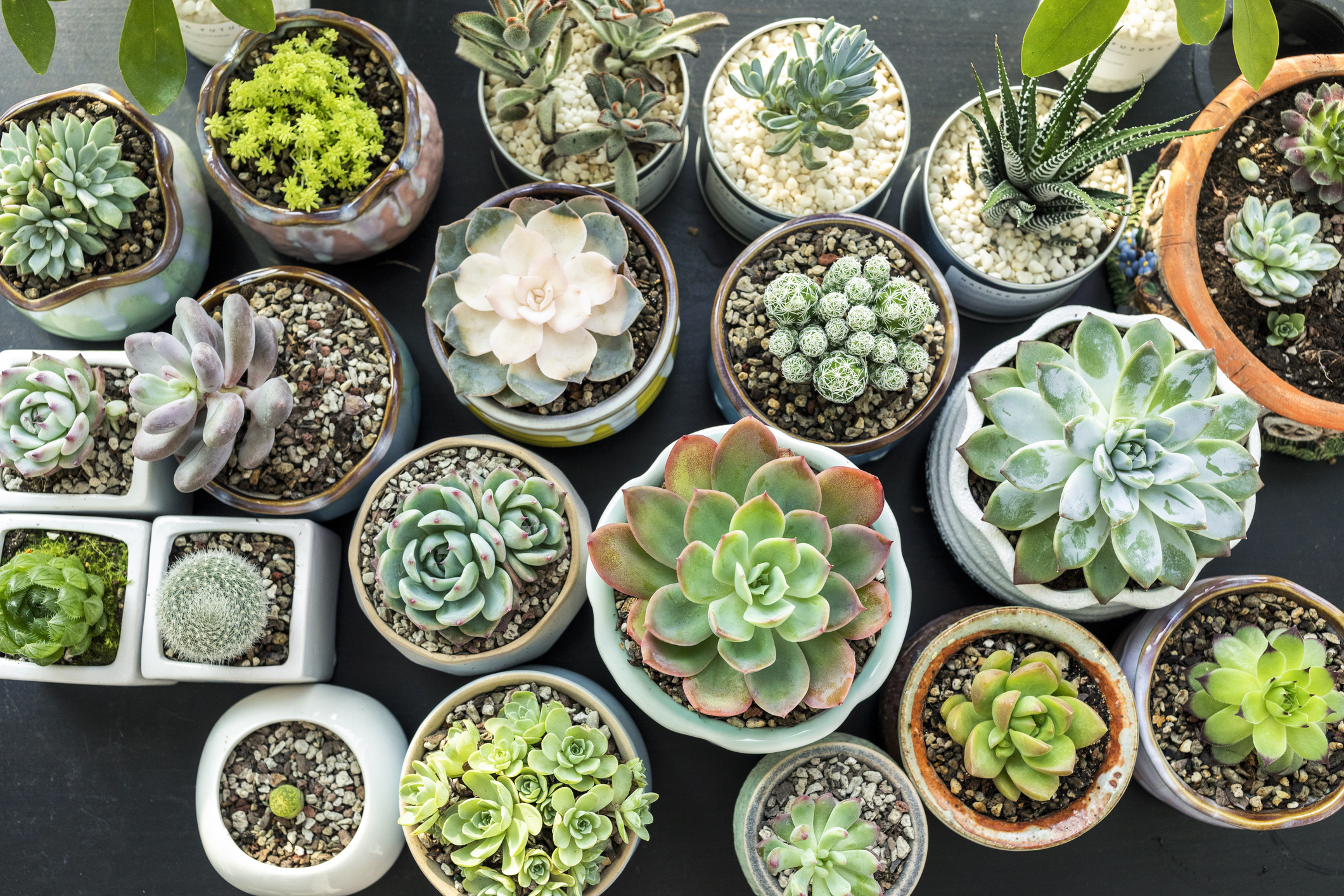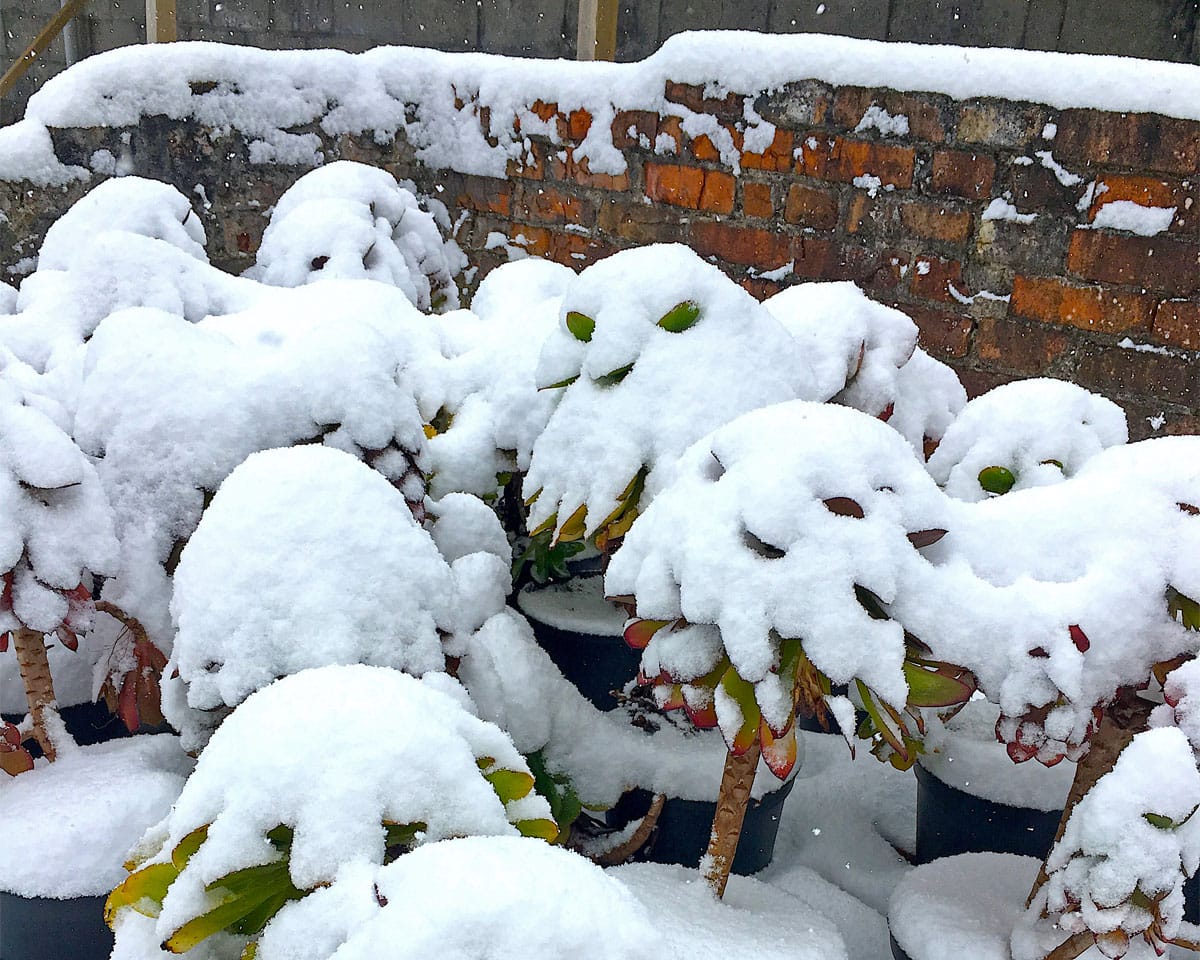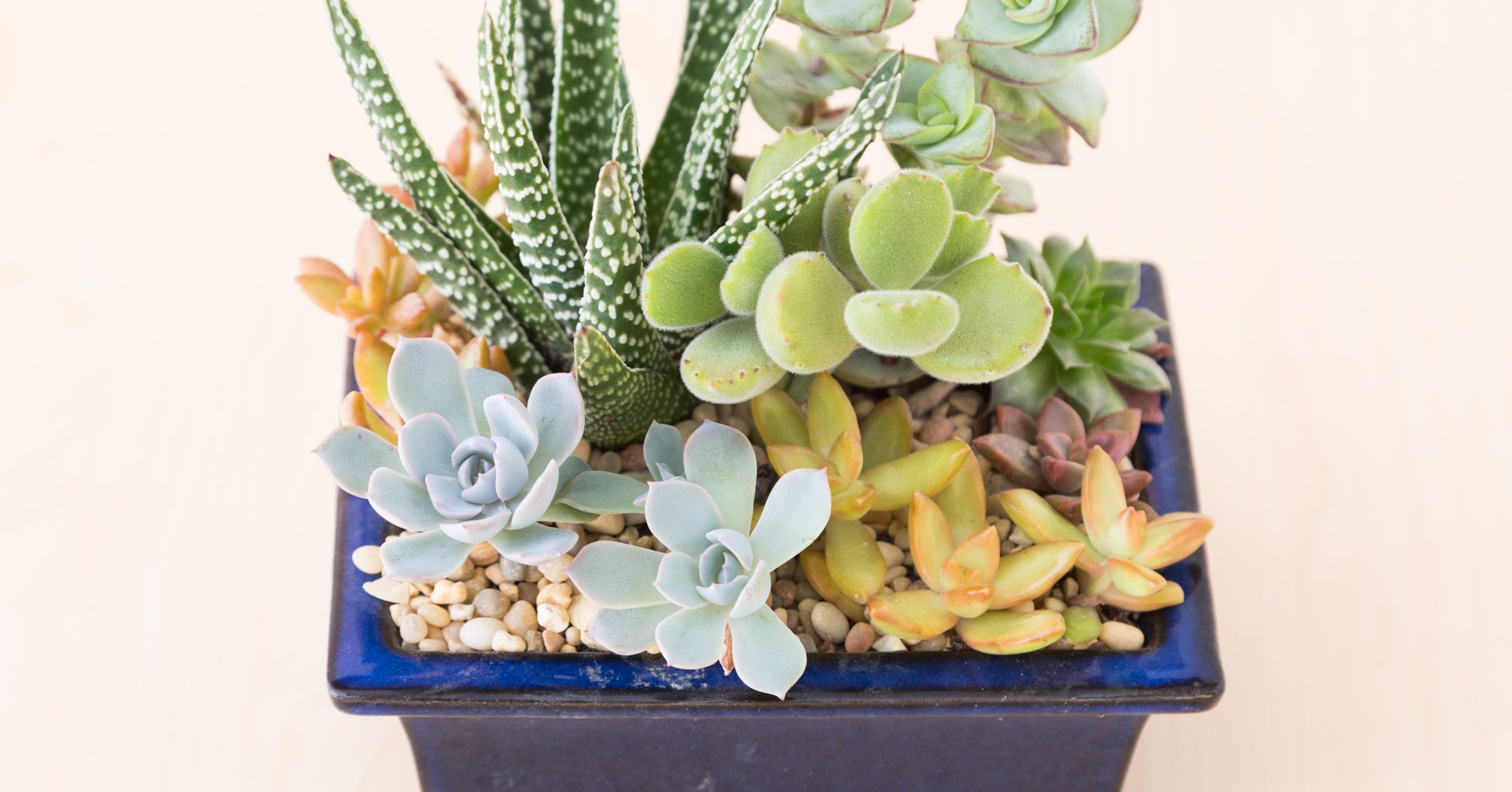Taking care of your succulents during the winter season doesn’t have to be confusing! This article will show you the right way to look after your indoor succulents during the cold months and a few hints to help you care for your outdoor succulent garden.
When you buy something by using a link from this site, we might get a commission without making you pay more. This helps us keep providing you with free content.
Depending on the climate in your area and the succulents you are cultivating, it may not be possible to keep them outdoors all year long.
If you have delicate succulents that cannot tolerate cold, snowy weather, you must move them indoors during the winter months in order for them to remain alive.
Table of Contents
When should I bring my succulents inside for winter?
The timing of when to bring your succulents indoors depends on your location and the types of plants you’re growing. Generally, it’s best to move them in before the first frost, which in many places in the US occurs in late September.
If you have cold hardy succulents, they can remain outdoors throughout the winter season.
It is essential to be aware of the climate conditions in your region. You should have a basic understanding of the average minimum temperature for your locality. For instance, when I lived in Utah, the area was classified as Zone 5. However, the majority of succulents I owned at the time were suitable for Zone 9.
All succulents with a hardiness rating below Zone 5 cannot tolerate cold temperatures and must be brought indoors during the winter.
I reside in the Phoenix area, a Zone 9, so most of my succulents can stay outdoors without any issues all year long. The only succulents that will require protection during the winter are the ones rated to Zone 10 or 11.
Begin by figuring out which type of succulents you have. Next, check what hardiness zone you are located in. Compare the two and figure out which plants you need to bring in to your area that have a higher hardiness rating than your current location.
This video will also assist you in deciding if you should move your succulents indoors for the winter season.
Moving Outdoor Succulents Inside
Water Outside
Rather than dealing with the hassle of watering succulents indoors, give them one final watering outdoors before bringing them indoors.
Suggested: Water your succulents two to three days before you bring them indoors. This will give them a chance to absorb the moisture they need and begin to dry out, so that your surfaces remain dry when they are inside.
Well Draining Soil
It is important to ensure that your succulents are planted in soil that allows for good drainage and are kept in a pot with a drainage hole. For indoor succulents to be successful, it is essential that they are placed in a pot and soil that will promote proper drainage.
If you don’t feel like mixing up your own succulent soil, I highly recommend Bonsai Jack’s succulent soil mix. It’s the same recipe I used to make at home, but you don’t have to put in all the time and effort. Your succulents will be very happy with the proper soil they get from this product.
Prep the Pot for Inside
Be sure to clear away any dead leaves or other organic material from around or between your succulents. This will prevent your plants from rotting or becoming infected.
I’m a fan of my mini tool kit, which assists in this procedure. After getting rid of anything superfluous, you can also add or exchange the top dressing to give the arrangement a more polished look.
- He’s a real pain in the neck.
He’s a real nuisance.
Check for Bugs
When you bring your succulents indoors, make sure to carefully check them for any signs of mealybugs, the most frequent pest of succulents. This way, you can avoid having uninvited visitors in your home.
Check out your plants for any other kinds of insects, such as ants, potato bugs, or spiders. I often find these kinds of bugs in my own planters.
Attempt to minimize the number of these tiny creatures in order to maintain the health of your succulents when grown indoors.
Refresh the arrangement
It is essential to regularly trim and care for your succulents to keep them healthy. Doing this regularly, especially prior to the winter, is important for the succulent’s longevity. Leaves may start to drop off as the succulent grows, but this can be managed by proper pruning.
Employ the tweezers or your own digits to pluck out the deceased foliage from the succulent; this will assist in keeping the plant from decaying while indoors.
Now is an ideal moment to replace the deceased succulent in your arrangement since one of them bloomed and left a spot open. The rest of the arrangement held up well through the summer.
I filled the hole with a few pieces of succulent plants and it looks full again. To finish it off, I spread some soil over the top to give it a finished look.
- He’s not ready yet. = He still needs more time.
Winter Watering for Succulents
Now that you’ve brought your succulents indoors, it’s time to give them the care they need!
During the winter, many succulents go into dormancy and require less water. Nevertheless, some are still in an active growth phase and will need more care.
Check out my post on dormancy to learn which succulents are winter growers and which are summer growers. By reading it, you’ll be able to figure out if your succulents are actively growing or dormant during the winter months. Click here to read it.
If you’re not sure what type of succulent you have, this post can offer you some assistance.
If your succulents are winter growers, they will likely require more frequent watering than usual. My Aeonium ‘Zwartkop’ is a particularly thirsty succulent during the cold season, needing to be watered much more often than in other times of the year.
Generally speaking, you should only give your plants water when the soil has completely dried out. Allow the soil to remain dry for a few days, or even up to a couple of weeks, before giving them another drink.
If you’re unsure of how to tell when your succulent needs water, make sure to check out our free guide, Signs Your Succulents Need Water, for more information.
It is much more difficult to properly regulate moisture indoors than outdoors, so without the right soil, over-watering is a common issue that can kill your succulent. To prevent this, be careful not to water too often.
Be mindful that succulents close to a heating duct may require more frequent watering due to the direct air and warmer temperature, which can cause them to dry out faster.
Plenty of Sunlight
Obtaining the correct amount of sunlight for succulents when growing them indoors, particularly during the winter, is a major challenge.
For your succulents to thrive, you should position them close to a window that receives plenty of bright, indirect sunlight throughout the day.
Since the days are shorter in the wintertime, it is crucial to ensure that succulents indoors receive at least 8 hours of bright indirect sunlight each day in order to retain their shape.
On gray, cloudy days during the winter, you may notice your succulents reaching for the window or leaning in its direction. This is an indication that they are not receiving enough sunlight.
In order to counteract any leaning, you can turn your succulents around. However, to stop them from stretching, you will need to add a grow light.
Be wary not to leave your succulents exposed to light constantly, as they need darkness during the night in order to properly develop.
If succulents become elongated or start to look spindly during the winter months, you can take cuttings from the top of the plant and propagate them to create even more plants to enjoy in the summertime.
It is more beneficial to propagate succulents in the spring, as they usually do not grow as quickly during the winter season. To understand how to do this, please refer to my post on stretching succulents for more information.
Frost Damage on Tender Succulents
If succulents are exposed to temperatures below their threshold, it can lead to frost or cold damage, which can be an unpleasant sight.
In regions that experience relatively mild winters (such as zones 8 or 9), you can use a frost cloth to protect your succulents during the few nights when temperatures dip below freezing.
Nevertheless, this is not an adequate answer for areas with frigid temperatures that remain below freezing year-round.
It would be unwise to leave your succulents outdoors in freezing temperatures, even if they appear to be fine. The effects of frost may not be immediately apparent and could take up to a few days to become visible.
I experienced a loss of my tender succulents while living in Utah when I left them outside for a few nights when temperatures dropped below freezing.
They appeared to be in good health on the first two days, but on the third day…
The most common symptom of cold weather damage on these plants was dark, soft tissue. This is due to the cells in the plant freezing and bursting, which creates the appearance of rot.
The Aeonium below was shielded from the cold by other plants, which helped it endure the frost better than its counterparts that were exposed.
It is essential to be aware of what type of succulents you possess and how much heat they can endure.
Make sure to visit our Types of Succulents page to find out more about the different kinds of succulents.
You can get our book, Choosing the Best Succulents, for advice on which succulents to grow based on your location, watering preferences, and more!
How to help succulents with frostbite
What steps should you take if your succulents have already been exposed to cold temperatures?
The initial step is to get the affected people to a warmer environment in order to prevent further exposure to the frigid temperature.
Allow the frostbitten areas to heal over the course of several days or weeks, depending on how severe the damage is. This will give the plant time to recover from the frostbite and form scabs to protect itself from further harm. During this time, your succulent will be in a state of emergency.
If you water your succulent immediately after it has been exposed to frost, it is more likely to decompose and not survive.
Once the affected parts of the plant have thawed, trim away the damaged areas if feasible. This could involve cutting away large sections of the plant or simply snipping off the tips.
For instance, if an Aloe or Agave leaf is beginning to dry out, trimming it can make it look like an ordinary Aloe or Agave leaf. Simply cut away the dry, brittle parts and discard them.
The ideal situation is for frostbite to only target the outer parts of your succulent and leave the middle undamaged.
If the frostbite has penetrated the stem of the succulent, it is unlikely to be able to be saved. To give your plant a chance, you should remove and discard any parts of the succulent that have been affected by the frostbite, and clean out the remaining parts of the plant. This may give your succulent a chance of survival.
Wait 2-3 days after trimming any damaged parts before watering the plant to allow the cuts to scab over and heal.
Once all the soil has had a chance to dry out, it’s time to give your succulent a good drink. Use the soak and dry technique I mentioned to help the roots develop properly.
It is essential to be aware that the parts that have been cut away from your succulents will not regenerate. However, if everything goes smoothly, the new growth of your succulent should look healthy and normal.
It may take a while for the succulent to regain its original beauty, but it will be worth the wait. As the succulent grows and develops over the coming weeks and months, it should soon look like its old, vibrant self again.
Ensure that when you return the succulent to its original location, it is shielded from both cold temperatures as well as too much heat or direct sunlight. Gradually reintroduce the plant to its previous environment to ensure it does not suffer from shock.
Stunning your succulent with sudden shifts in temperature or exposure to intense sunlight can cause damage.
FAQ
Can succulents survive outside in winter?
How do you take care of potted succulents in the winter?
Succulents become dormant during the winter, meaning they don’t need as much water. When temperatures drop and the days become shorter, it is best to stop watering them completely or only water them once a month. Before watering, it is recommended to check the soil moisture level to make sure the succulents are not being over-watered.
Should I bring my potted succulents inside for winter?
Before the temperature drops to freezing, you should bring your delicate, non-frost-tolerant succulents indoors. Check the container for any pests like ants, spiders, or other small bugs, and remove them. Additionally, take away any dead leaves, twigs, and other debris from the potting soil.
Where should I put my succulents in the winter?
To prepare succulents for winter, it is important to shield them from icy temperatures. This can be done by bringing them indoors, placing them in a sunny area, near a protected wall, or in a greenhouse or conservatory. Additionally, succulents benefit from being situated on a covered porch.
How do you keep succulents alive in the winter?
…
– Move succulents inside when temperatures drop.



